- Home
- Basic Lessons
- Japanese Nouns
Japanese Nouns -
Free Japanese Lessons: 2
Japanese nouns or 名詞 (meishi) can be expressed in the past tense! Did you know that? I was quite surprised when I first found out.
This is different from English, where tenses are not required for nouns.
Having said that, Japanese nouns have no plural form nor gender, which often cause confusion in other languages.
Sentence Pattern
Let's take a look at the following sentence pattern using nouns:
Noun A は Noun B です
Noun A wa Noun B de su
Meaning: Noun A is Noun B
Particle は (wa) indicates that the Noun A before it is the topic of the sentence. By adding は to Noun A to make it the topic (topic marker), you are then able to make a statement about the topic. For example,
- ジョンさんはせんせいです。
jon san wa sen sei de su
Meaning: John is a teacher.
Please note that は should read as wa, the same sound as わ, when it is used as a particle. See more explanations on the particle は (wa) in Japanese hiragana.
The ending word です (de su) does not have any meaning.
- It is used with the second noun せんせい (sen sei) to work as a predicate.
- It is served as a judgement in the above Japanese noun sentence.
- It also conveys the message that the speaker is being polite towards the listener.
- When you are pronouncing です (de su), the "u" sound in "su" is silent and hence it actually sounds like "de s".
- It will change when the Japanese noun sentence becomes negative or it is in the past tense (I will touch on past tense in future lessons).
Negative Form of Japanese Nouns
Now let's look at the negative form of Japanese nouns:
Noun A は Noun B ではありません
Noun A wa Noun B de wa a ri ma sen
Meaning: Noun A is not Noun B
You should be able to guess that ではありません is the negative form of です. For example,
- ジョンさんはせんせいではありません。
jon san wa sen sei de wa a ri ma sen
Meaning: John is not a teacher.
Again, は in ではありません should read as wa.
Japanese Noun Sentences with Particle も (mo)
The particle も (mo) is also a topic marker, except that it is used in place of は (wa) when the statement about the topic is the same as the previous topic in Japanese noun sentence. For example,
- ジョンさんはせんせいです。
jon san wa sen sei de su
マイクさんもせんせいです。
ma i ku san mo sen sei de su
Meaning:
John is a teacher.
Mike is also a teacher.
However if the topic is different from the previous topic, you still need to use は (wa). For example,
- ジョンさんはせんせいです。
jon san wa sen sei de su
マイクさんはがくせいです。
ma i ku san wa ga ku sei de su
Meaning:
John is a teacher.
Mike is a student.
Questions in Japanese Noun Sentences
You can change the sentence into a question by simply adding か (ka) at the end of the sentence in Japanese nouns.
This is really much simpler as compared to an English sentence where you have to change the order of the words to form a question. For example,
- ジョンさんはせんせいですか。
jon san wa sen sei de su ka
Meaning: Is John a teacher?
The particle か (ka) expresses the speaker's question, doubt and uncertainty regarding something. Take note that か should read with a rising tone to indicate it is a question.
So how do you answer to the above Japanese noun question? The question above is asking whether you agree or disagree with the statement, therefore requires you to give a 'Yes' or 'No' answer.
You will normally begin the answer with 'Yes' or 'No', which is はい (ha i) or いいえ (i i e). We will call that a Yes/No question. Look at the following examples:
- Question: ジョンさんはせんせいですか。
jon san wa sen sei de su ka
Answer: はい、ジョンさんはせんせいです。
ha i, jon san wa sen sei de su
Meaning:
Question: Is John a teacher?
Answer: Yes, John is a teacher.
- Question: マイクさんはせんせいですか。
ma i ku san wa sen sei de su ka
Answer: いいえ、マイクさんはせんせいではありません。
i i e, ma i ku san wa sen sei de wa a ri ma sen
Meaning:
Question: Is Mike a teacher?
Answer: No, Mike is not a teacher.
Japanese Comma (、) and Full Stop (。)
Do you notice that the commas used in the previous examples are different from what you normally use? In Japanese, the comma sign is "、" instead of ",".
Similarly, the full stop sign is "。" instead of ".". Moreover, with the question word か (ka), you don't really need to add the question mark sign "?" at the end of the sentence.
Combining も (mo) and Question Word か (ka)
You can also use も (mo) together with か (ka) in a question in Japanese nouns. For example,
- Question: ジョンさんはせんせいですか。
jon san wa sen sei de su ka
Answer: はい、ジョンさんはせんせいです。
ha i, jon san wa sen sei de su
Question: メリーさんもせんせいですか。
me ri- san mo sen sei de su ka
Answer: はい、メリーさんもせんせいです。
ha i, me ri- san mo sen sei de su
Meaning:
Question: Is John a teacher?
Answer: Yes, John is a teacher.
Question: Is Mary a teacher too?
Answer: Yes, Mary is a teacher too.
However, if Mary is not a teacher, you cannot use も (mo) as the topic is different from the previous topic. So the answer should be:
- Answer: いいえ、メリーさんはせんせいではありません。
i i e, me ri- san wa sen sei de wa a ri ma sen
Meaning:
Answer: No, Mary is not a teacher.
Negative Form Questions
You can also add the question word か (ka) to a negative form sentence in Japanese nouns. For example,
- Question: マイクさんはせんせいではありませんか。
ma i ku san wa sen sei de wa a ri ma sen ka
Answer: はい、マイクさんはせんせいではありません。
ha i, ma i ku san wa sen sei de wa a ri ma sen
Meaning:
Question: Isn't Mike a teacher?
Answer : No, Mike is not a teacher.
But if Mike is a teacher, you should give the answer:
- Answer: いいえ、マイクさんはせんせいです。
i i e, ma i ku san wa sen sei de su
Meaning:
Answer: Yes, Mike is a teacher.
Please be careful not to get confused with the meanings of はい (ha i) and いいえ (i i e) with the yes and no in English.
The meaning of はい (ha i) in Japanese is "I agree with what you said" and the meaning of いいえ (i i e) is "I don't agree with what you said", which are different from the plain yes/no meanings in English.
Therefore, though you responded with "No, Mike is not a teacher." to the question "Isn't Mike a teacher?", your answer in Japanese is "はい、マイクさんはせんせいではありません。".
That is because the meaning of "はい" here is "I agree with what you said in that Mike is not a teacher".
If your response to the question "Isn't Mike a teacher?" is "Yes, Mike is a teacher.", your response in Japanese should be "いいえ、マイクさんはせんせいです。".
That is because the meaning of "いいえ" here is "I disagree with what you said that Mike is not a teacher".
Adding も (mo) to Negative Form Questions
Similarly, adding も (mo) to the negative form question in Japanese nouns gives:
- Question: マイクさんはせんせいですか。
ma i ku san wa sen sei de su ka
Answer: いいえ、マイクさんはせんせいではありません。
i i e, ma i ku san wa sen sei de wa a ri ma sen
Question: アランさんもせんせいではありませんか。
a ran san mo sen sei de wa a ri ma sen ka
Answer: はい、アランさんもせんせいではありません。
ha i, a ran san mo sen sei de wa a ri ma sen
Meaning:
Question: Is Mike a teacher?
Answer : No, Mike is not a teacher.
Question: Isn't Alan a teacher too?
Answer : No, Alan is not a teacher too.
But if Alan is a teacher, you should give the answer:
- Answer: いいえ、アランさんはせんせいです。
i i e, a ran san wa sen sei de su
Meaning:
Answer: Yes, Alan is a teacher.
Related Pages
Lesson 3: Nouns Part 2 - Using one noun to modify another noun.
Lesson 13: Nouns Part 3 - Action before and after Noun.
Lesson 27: Noun Modifier.
Best Deal of the Year! Get 68% OFF Lifetime Premium! Ends on 13 Dec 2025
Click Here to Get 68% OFF Lifetime Premium and be on the fast track to fluency in Japanese.
The link above is an affiliate link, which means that I would earn a commission (at no extra cost to you) if you do end up purchasing the related learning course.
Previous - Lesson 1: Japanese Greetings
Next - Lesson 3: Nouns Part 2
Buy me a coffee









Facebook Comments
Don’t see the comments box? Log in to your Facebook account, give Facebook consent, then return to this page and refresh it.